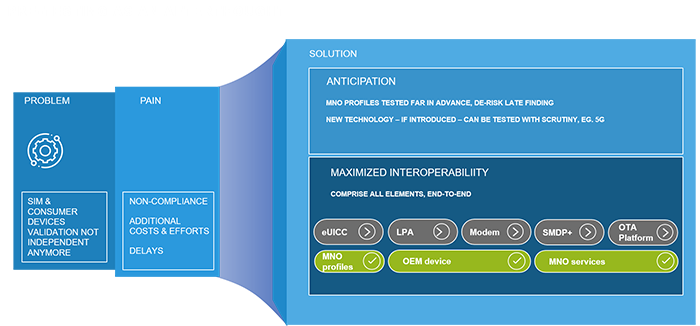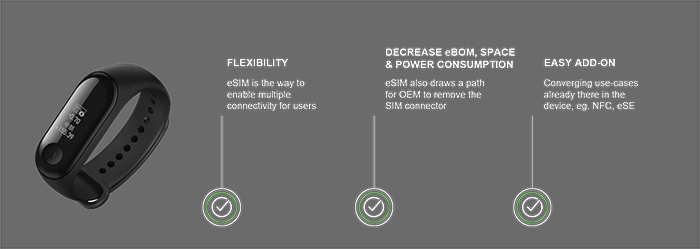3 ways not to screw up an eSIM design
After remaining essentially unchanged for more than 25 years, the Subscriber Identity Modules (SIMs) used to authenticate devices onto cellular networks are undergoing a dramatic transformation, moving from physical hardware to downloadable software – embodied by the concept of eSIMs. Cyril Caillaud, NXP Semiconductors, explains.
Adopting the eSIM approach delivers a number of important benefits, and the transition to eSIMs is solidly underway. The Trusted Connectivity Alliance reports that 2020 was a breakout year for eSIMs, with 83% year-on-year growth and a total of 309 million units shipped. Increases in eSIM shipments were mainly driven by the launch of new eSIM-enabled smartphone models, smartwatches and IoT devices.
Avoiding pitfalls
NXP, among others, is a strong supporter of the transition to eSIMs and encourages its customers to consider them for their new designs. On the other hand, eSIM integration effort can come with a few surprises. The cellular ecosystem is a complex place to operate, and eSIMs need to perform seamlessly under a wide variety of conditions. It’s important to get the details right.
The eSIM needs to perform as flawlessly as possible, wherever and however it’s deployed, and that means interoperability is an absolute must. Ensuring interoperability can take time though, and most development cycles don’t have time to waste. To help customers anticipate trouble spots and avoid costly delays, or even drift in service launch, there are three recommend best practices.

Above: Image Source: Trusted Connectivity Alliance, TRE Insights (PDF)
1. Start with standards
Standards are essential in cellular, since they help create a baseline for interoperability and security. By following the specifications of a given standard, developers gain the benefit of working in an agnostic ecosystem, with many players and lots of choice when it comes to creating a competitive design. Standards also tend to emphasise security, and address many of the challenges associated with protecting data and privacy. Another benefit of standards is that they serve as the basis for interoperability testing, by providing guidelines for test suites and, more recently, sponsoring industry-targeted ‘Test Fests’, which let developers test and verify their product implementations in a multi-vendor and end-to-end environment.
The list of standards bodies relevant to cellular is long, and getting longer. The 3GPP and ETSI define each generation of cellular, but there are other compliance guidelines to keep in mind too, including those issued by GlobalPlatform, GSMA, ENISA, and EuroSmart. For eSIMs in particular, the Trusted Connectivity Alliance (TCA) works in close partnership with GSMA and other industry associations to develop enabling specifications that support trusted connectivity.

Standardisation may be an essential part of interoperability, but true interoperability comes from frequent, rigorous, and thoughtful testing. Testing early and testing often is crucial. Here are some topics worth considering when defining the test strategy for an eSIM design:
Situations beyond the scope of standards: Standards aren’t a magic wand. They don’t always cover every scenario, and there are aspects of cellular operation they don’t really address. Developers are encouraged to think about the areas that fall outside standardisation, such as legacy profile structures and specific test suites from Mobile Network Operators (MNOs), proprietary back-end platforms behaviours for Over-The-Air (OTA) eSIM profile life cycle management.
Corner cases: Standards tend to focus on what’s ahead, which means backward compatibility may not be as complete as hoped. Design comprehensive tests that include all technologies, including past, present, and future. For example, 5G may be the focus right now, but there are plenty of 4G LTE and even 3G devices still out there, so it’s essential to include them in tests, too.
New and uncommon use cases: Every deployment is unique and involves the potential for interactions with devices that support new and uncommon use cases. This is where creative thinking can help to go deeper and develop test cases that help prepare for the unexpected.
Systems external to the eSIM: The eSIM is part of a larger design that involves a wide variety of external systems. A deep dive into their operating characteristics is recommended, as well as developing tests for interoperability with, for example, the device’s host processor, the modem, and the Local Profile Assistant (LPA) used to manage profiles. Supporting technologies, such as the secure element, NFC, and UWB, should be also considered.
2. Begin testing early
For years plastic SIMs and devices have been independently developed and commercially deployed. eSIMs require a new approach. OEMs run their design schedules long before an MNO expects to see Technical Acceptance (TA) of the device. In consequence, the eUICC tests and design is finished before the MNO testing even started, carrying the risk of a misalignment in features and the service roadmap next to a number of unanticipated issues for both MNOs and OEMs. If the eSIM will only get tested once the MNOs enter the Device TA phase, there is a high likelihood that trouble spots will arise, including:
- Non-compliance with MNOs backend and profiles
- Unexpected costs
- Lack of resources
These all eventually lead to a delay of the device and eSIM service launch.
Follow the communication chain: To help confirm that nothing has been missed, the cellular connection needs to be followed from start to finish - testing to ensure that the eSIM works with the MNO connectivity profile as well as device LPA, that the LPA works with the Subscriber Management – Data Preparation (SM-DP+) platform, that the OTA platform works fine with the connectivity profile, and so on (see image opposite). Anticipated testing is key to ensure mass adoption. When devices eventually kick into the MNO portfolio, all actors in the chain can have confidence in the technical compliance.
3. Use integration to your advantage
Choosing a solution that combines the eSIM function with other components can help save time, money and simplify the design effort, while also adding new features. The NXP SN110U, for example, is a single-die chipset that is CC-certified and features an embedded secure element and an NFC function along with a GSMA consumer compliant eSIM.
The high level of integration means the SN110U provides cellular connectivity along with security and advanced functionality in a single, small footprint. That simplifies testing, reduces the device board space occupation, and decreases the power consumption, since there are fewer component interactions to integrate and verify. Common Criteria certification serves to reassure developers that their design delivers end-to-end security and offers safe, tamper-resistant data protection – all without forcing developers to become security experts or deal with security code.
The way forward
When working in a market as fragmented as cellular, creating an interoperable eSIM design can be a make or break proposition. By planning ahead, and taking a holistic view of design and tests, developers can deliver exceptional new products while avoiding incompatibility issues and other kinds of surprises that can derail the development effort.




